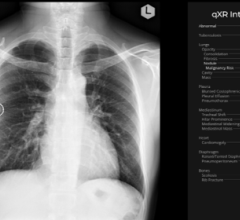
March 7, 2016 — Adults aged 55-74 years who are at high risk of lung cancer should be screened annually up to three times using low-dose computed tomography (CT), according to a new guideline from the Canadian Task Force on Preventive Health Care (CTFPHC). The guideline was published in the Canadian Medical Association Journal (CMAJ).
Lung cancer is the most common cancer in Canada and the number one cause of deaths from cancer. In 2015, about 26,600 Canadians were diagnosed with lung cancer, and almost 21,000 died from it. Most cases of lung cancer, about 85 percent, are linked to tobacco smoking.
"Screening for lung cancer aims to detect disease at an earlier stage, when it may respond better to treatment and be less likely to cause serious illness or death," stated Gabriela Lewin, M.D., chair of the CTFPHC guideline working group.
This guideline incorporates new evidence, including results from a large randomized controlled trial comparing low-dose CT with chest X-rays, and balances the benefits of early detection with the harms of overdiagnosis and invasive follow-up testing. It replaces the 2003 guideline from the CTFPHC.
Key recommendations from the guideline include:
- Adults aged 55-74 years who are at high risk of lung cancer (i.e., current or former smokers [have quit within 15 years] with at least a 30 pack-year history or more) should be screened annually up to three consecutive times using low-dose CT;
- Screening must be conducted in a healthcare setting with expertise in diagnosing and treating lung cancer;
- For all other adults, the task force recommends not screening for lung cancer, regardless of age or smoking history; and
- The task force recommends not using chest X-rays to screen for lung cancer.
These recommendations do not apply to people with a family history of lung cancer or who have symptoms suggestive of lung cancer. For people with other risk factors for lung cancer, such as radon exposure, exposure to second-hand smoke and previous radiation to the chest, it is unknown whether they would benefit from screening with low-dose CT.
The task force recommends that physicians should have a conversation about screening preferences with patients at high risk of lung cancer, considering age, health status and ability to benefit from potential treatment.
"People who place a higher value on a potential mortality benefit and are less concerned with the harms associated with screening (e.g., high false-positive rate, complications from follow-up testing) will be more likely to choose screening, whereas those more concerned with the harms and small mortality benefit may choose not to be screened," stated Lewin.
There are currently no organized screening programs for lung cancer in the Canadian provinces or territories.
"Smoking remains the primary risk factor for lung cancer; therefore, interventions to promote smoking cessation (which have benefits beyond decreasing the risk of lung cancer) should be incorporated into any screening program aimed at reducing lung cancer morbidity and mortality," write the task force members.
Although these new recommendations are similar to other Canadian and international guidelines, the task force's recommendation to screen annually over three consecutive years is more conservative than the others, which recommend ongoing annual or biennial screening.
For more information: www.canadiantaskforce.ca


 December 10, 2025
December 10, 2025 









